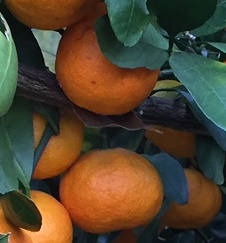
by Matthew Orwat | Dec 7, 2016
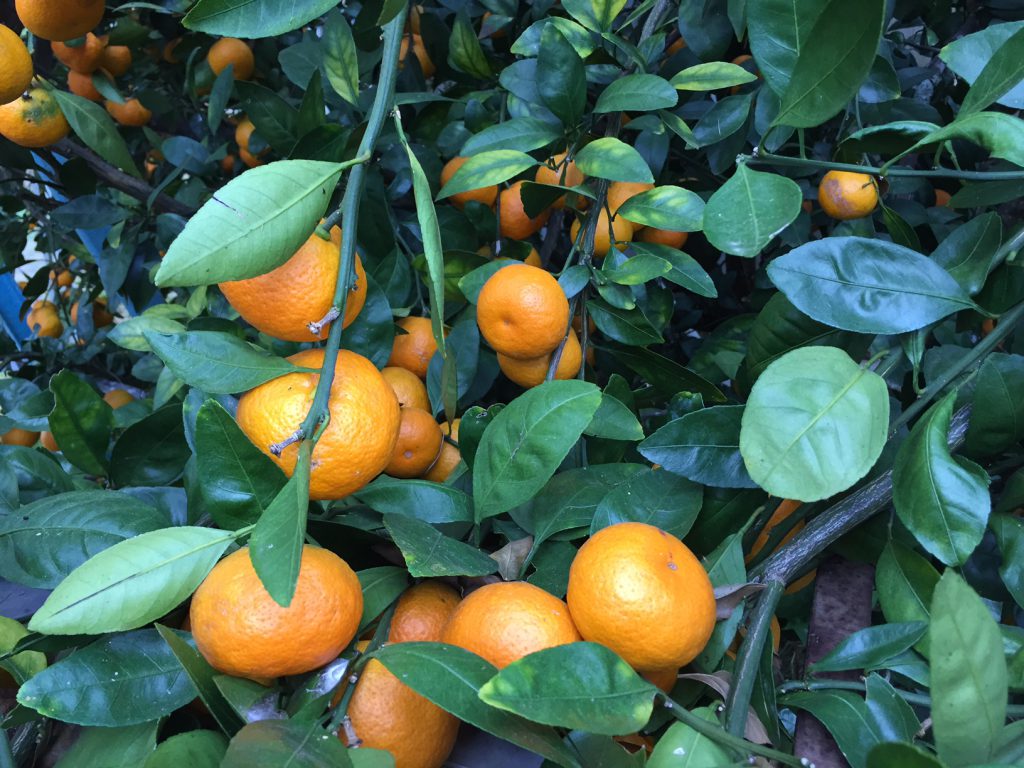
Fall 2016 Satsumas. Image Credit: Matthew Orwat
One question that repeatedly pops up in my Extension work is “When do I harvest fruit or vegetable X ?” This fall, the question of “when should I harvest my citrus?” has been a choice topic! The most common citrus in the Florida panhandle is the satsuma, Citrus unshiu, so it makes sense to limit this article to that species.
Harvesting satsumas can be a confusing activity for new citrus enthusiasts. Fall seasons in the panhandle tend to be extremely variable, from cold and wet to warm and dry or any combination thereof. To complicate matters, citrus is often grown in a protected microclimate in the garden. Thus, another variable is added to the decision tree.
Some harvest considerations to take note of:
- Sometimes the fruit is ready to harvest even when some green remains on the fruit
- Not all fruit on a given tree will be ready at the same time
- It’s a good idea to harvest a few fruit per tree and taste test….this will be a good indicator of the readiness of the other fruit on the tree
- A general trend to consider is that the longer the fruit remains on the tree, the sweeter it will become

Image Credit Matthew Orwat
When satsuma ripen, they become slightly soft. That’s a good indicator that they are ready to harvest. This softness makes them extremely easy to peel but poses a challenge when harvesting. If they are simply pulled off of the tree, some peel will be left on the tree and the fruit will be compromised. Such a fruit would have to be consumed quickly. To solve this problem satsuma are clipped off the tree, leaving a tiny bit of stem attached to the fruit. This allows the fruit to be stored and transported.
When a hard freeze is approaching (5 hours below 28ºF), it is important to harvest the fruit before this event whether or not they are ripe. Hard freezes will ruin the texture of the fruit and cause them to begin the rotting process.
Since a hard freeze is forecast for Friday December 9th 2016 for part of the Florida Panhandle, consult your local weather forecast and make your decisions accordingly. For an in-depth discussion on citrus fruit harvesting and cold tolerances, please consult this publication from Texas A& M University. Additional articles are available on cold protection and frost readiness here.
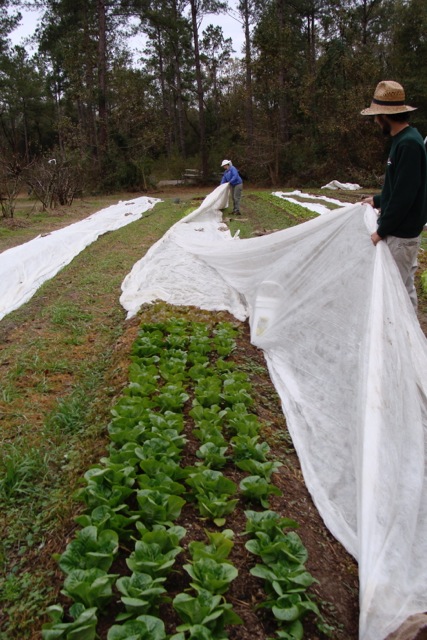
by Molly Jameson | Nov 4, 2015

Covering a row of lettuce with frost cloth at Turkey Hill Farm. Photo by Turkey Hill Farm.
While most of Florida does not have to worry about freezing winter weather, the Florida Panhandle is certainly an exception. North Florida experiences a few hard freezes – temperatures less than 28°F for over five hours – every year. Although most of our cold weather occurs in January and February, we can expect our first frost around the second week of November. Therefore, it is important for gardeners to be prepared.
Most of the Panhandle is in zone 8b, which means average minimum temperatures are between 15 and 20°F. Nights – especially consecutive nights – that get this cold can “burn” the tips of even the toughest vegetables, such as collards and kale. It is also important to remember that if you live in a more rural area, temperatures will be slightly cooler, relative to the city. Frost is also more likely to occur on clear nights, as heat that radiated down from the sun during the day will escape the atmosphere at night, if clouds are not present. Also, if you were late getting your fall garden started, it is even more important to protect your vegetable plants, as young plants are more susceptible to cold weather.
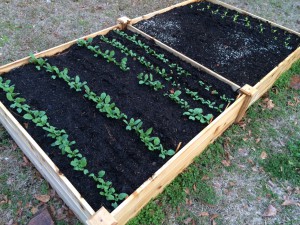
Young plants are more susceptible to cold weather, so be sure to use cold protection. Photo by Molly Jameson.
One strategy home gardeners can use to protect their plants during cold weather is to use frost cloth. Frost cloth is a breathable polyester fabric that is light weight and heat-retentive. It can moderate temperatures about six to eight degrees Fahrenheit. Use it on all of your garden plants if there is a hard freeze, but do not cover cold hardy vegetables in mild frosts, as their flavor can actually become sweeter in cool weather, and the plants will become more tolerant to the cold.
Frost cloth can be found at most plant nurseries, and it can last multiple years if you take care of it. Use wire hoops to keep the cloth off smaller crops, as ideally the cloth should not touch the plant. Most importantly, the cloth must touch the ground at all points to be effective, as it works by trapping heat that radiates from the soil and increases the humidity around the plant.
In the morning, do not remove frost cloth too early, as quick thawing can actually cause the most severe damage. Wait until the outside air temperature is about 50 to 60°F. Since frost cloth is breathable, if temperatures do not reach 50 to 60°F during the day, you can leave it on multiple days.
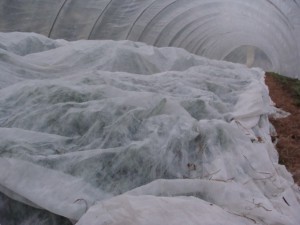
Frost cloth in high tunnel at Turkey Hill Farm. Photo by Turkey Hill Farm.
Sheets or blankets (not plastic) can be a frost cloth substitute, but there are disadvantages, such as not allowing proper air circulation or not being large enough to reach the ground.
Another strategy that can help keep your garden safe from cold weather is to keep your plants well watered, as frost damage is actually dehydration. When ice crystals form on the leaf surface, it draws moisture from the leaf tissue. Damage will therefore be less severe if the plant is not already drought-stressed. You can also mulch around the base of your plants with wood chips or straw to help moderate soil temperature and retain moisture.
Being prepared for cold weather will help keep your vegetable garden going strong all the way into the spring. Remember that healthy plants will be more resistant to cold weather than unhealthy plants, and investing in a few sheets of frost cloth can go a long way to ensure your veggies survive our chilly North Florida winters.
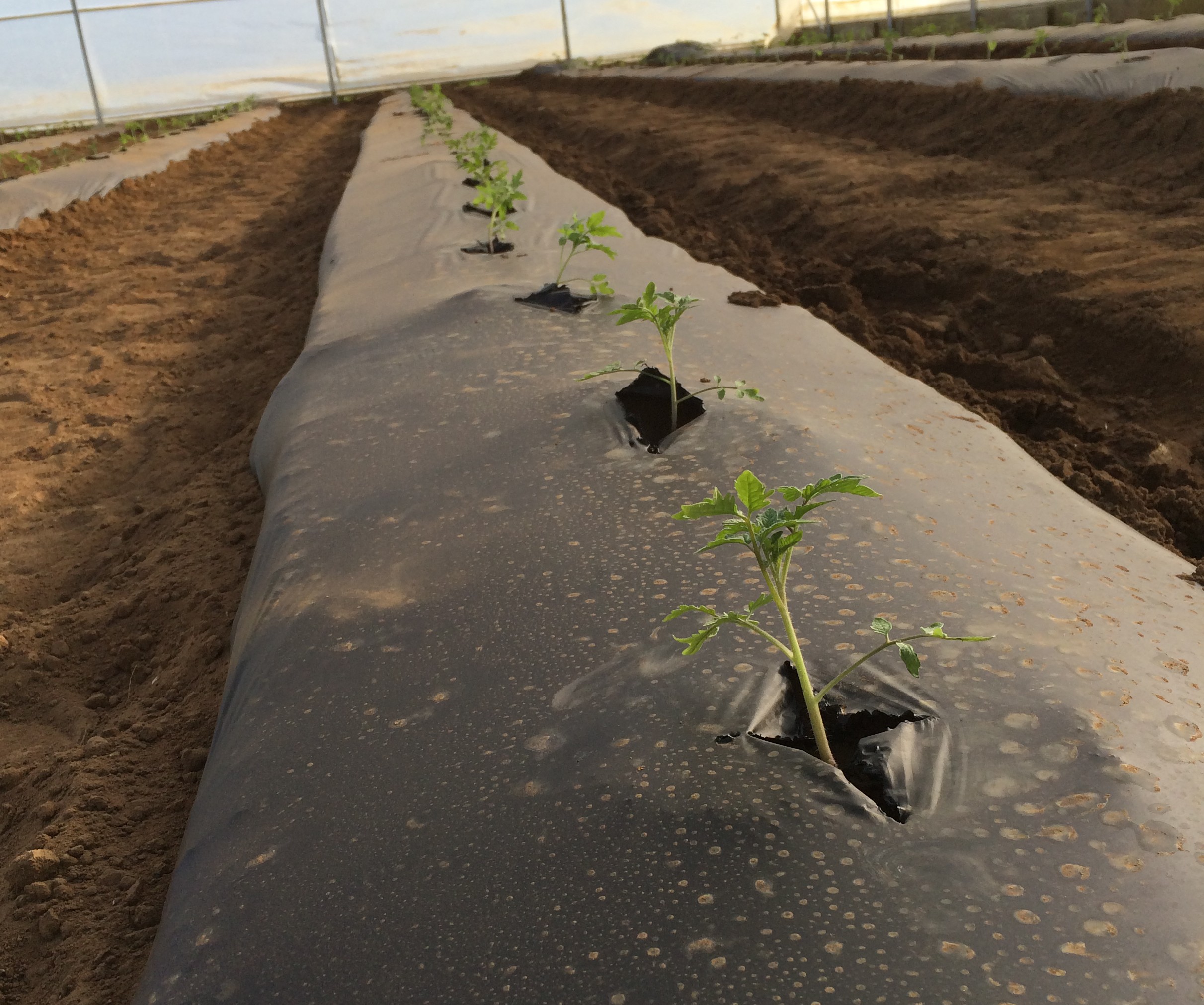
by Blake Thaxton | Jan 27, 2015
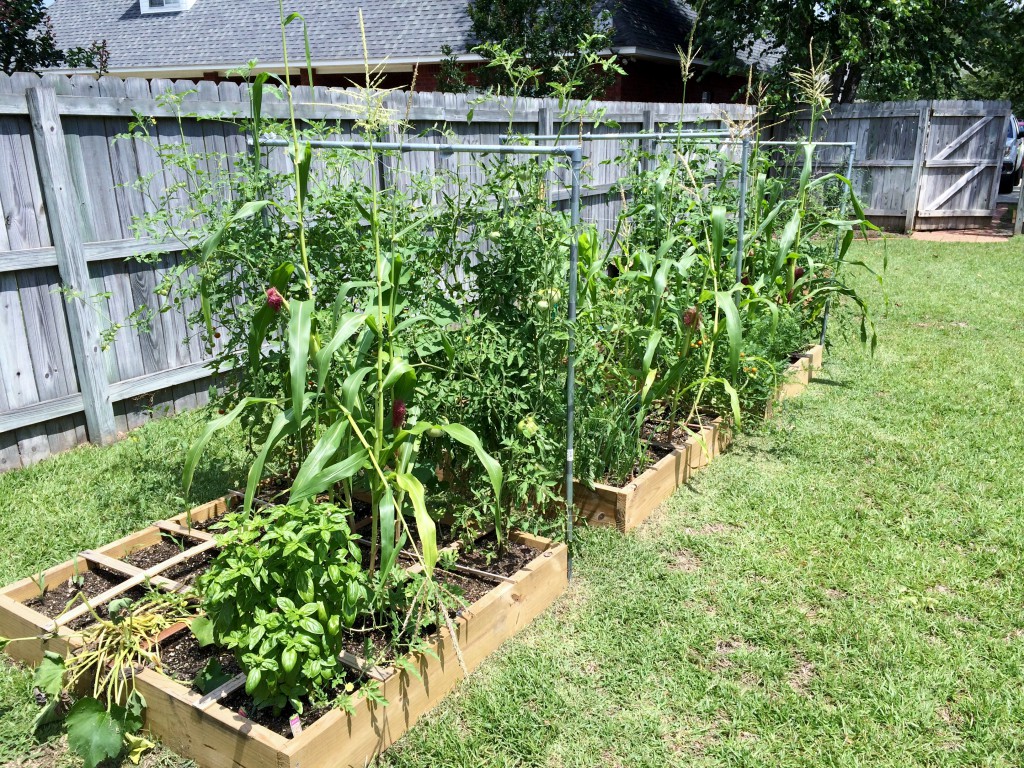
Raised bed spring vegetable garden in NW Florida – photo credit: Blake Thaxton
Growing spring vegetables in northwest Florida can be challenging! Sometimes failures seem more numerous than successes. Extreme cold events in the winter and blistering hot summer days make it tough on vegetables. One suggestion is to get the garden started earlier than usual!
The climate in northwest Florida challenges the gardener due to very high insect pest pressure and it being the perfect environment for fungal and bacterial diseases to grow. Hot and humid summers with moderate winters can be disastrous because diseases will be very active and the insects are not eliminated by extreme cold temperatures. Random cold temperatures in the spring make it hard to know when to plant the vegetable garden.
[important]Because insects and diseases become more active as it gets warmer in the spring, getting a head start may aid the success of your vegetable garden.[/important]
How can a gardener get a head start? Here are a few suggestions:
-
Start Vegetable Transplants Inside
Seems simple, but just getting seed started in a temperature controlled environment can help the vegetable plants get a leg up on the insect pests and diseases that are eminent. If you have a greenhouse structure, that would work perfectly. If not, consider starting your plants in a room with as much possible natural light. On warm days take the plants outside to get some sunshine.
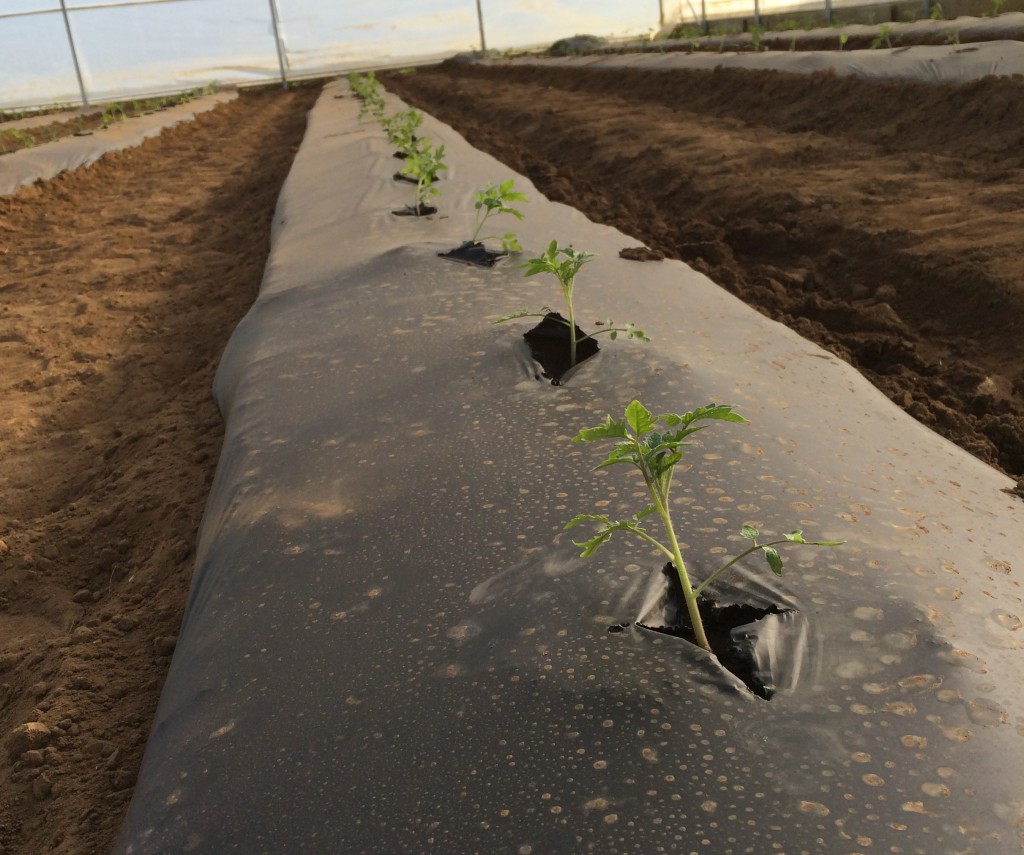
Tomato Plants grown with black plastic mulch – photo credit: Blake Thaxton
Black plastic mulch is commonly used in commercial vegetable production. One of its main functions is to help warm the soil to encourage root growth of the vegetable plants. Other benefits include good moisture and weed control.
Learn more from this Penn State Extension website: Plastic Mulches
Row Covers protect vegetable plants in the ground when temperatures drop lower than expected in the early spring. Row covers are transparent or semitransparent flexible materials used to cover a row of plants to help insulate the air around the plant from the colder temperatures and wind. If you can not find this kind of material you can always use black plastic nursery pots, Styrofoam cups, or other materials to protect individual small plants.
Learn more from this UF/IFAS publication: Row Covers for Growth Enhancement
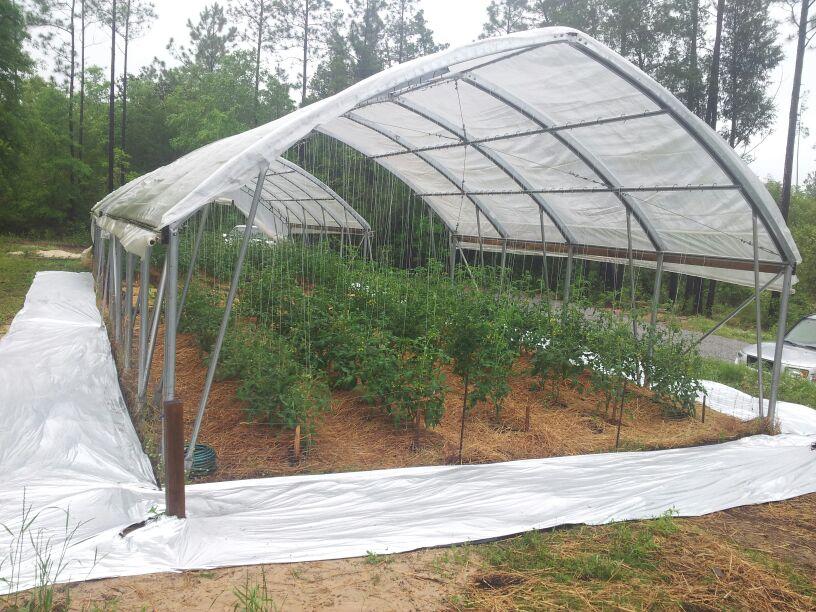
A High Tunnel with end walls and side walls removed for cooling warmer temperatures – photo credit: Blake Thaxton
Another method of protecting your vegetable garden from cold early spring temperatures is to construct a high tunnel, also known as a hoop house. A high tunnel is a structure that looks very much like a greenhouse but the crops are planted in native field soil and the structure lacks an active temperature control. The temperature is passively controlled by rolling up end walls and side walls on warm days and closing the walls when cool temperatures are expected.
Learn how to build a high tunnel from this video from Utah State Extension: How to Build a High Tunnel
For more information on any of these topics please contact your local UF/IFAS Extension Agent or email Blake Thaxton: bthaxton@ufl.edu
by Matthew Orwat | Nov 18, 2013
On the night of November 13th, a mild freeze of 30°F occured in parts of Northwest Florida. Don’t be caught without a citrus protection plan !
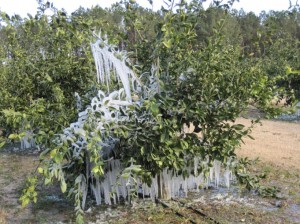
Satsuma Tree protected with micro-irrigation. Image Credit: UF IFAS Jackson County Extension
How cold does it have to get before citrus in Northwest Florida needs to be protected? A concrete answer to this question does not exist. Growers and home gardeners alike must consider several factors including type of citrus grown and the location of the citrus.
Below are a few quick facts to assist growers and home gardeners in determining whether to protect or not to protect their citrus:
- Certain citrus trees such as lime, pomelo, grapefruit, sweet orange, lemon and citron will definitely need protection or need to be moved into a sheltered area. Individuals that grow these types on a consistent basis either wrap their trees with protective covers each season or grow them in containers and move them into greenhouses.
- The meyer lemon, which is in reality a lemon-sweet orange hybrid, is a tree that was introduced to the united states in 1908. Mature dormant meyer lemons can be hardy down to 20°F, with fruit hardy to 26°F. Immature trees, or those that have not reached dormancy, should be protected. Covers made of cloth should be large enough to touch the ground so that heat from the soil can help keep the tree warm.
- Generally, satsuma are cold tolerant down to 15° F, but young trees or trees yet to achieve dormancy are usually only tolerant to 26°F. Fruit should not sustain damage from freezing temperatures above 25°F. Extreme winds sometimes make the effects of freeze events worse, so it is always better to err on the side of protection if the trees are planted in an exposed site.
- Kumquats are the most cold tolerant citrus type grown in Northwest Florida, so protection is not required unless freeze events reach 20°F.
Additional facts to assist the grower or home gardener with citrus protection:
- Plant trees on a south-facing slope, south of windbreaks, on the south side of a structure or under a light canopy if possible. South facing slopes block harmful cold winds. Structures offer radiant heat which aids in the protection of citrus trees. Additionally, light over-story pine canopies allow sufficient sunlight through while reducing frost damage.
- Wrap the trunk with commercial tree wrap or mound soil around the base of the tree up to 2 feet. This will protect the graft of the young tree. Thus, if the branches freeze the graft union will be protected.
- Cover the tree with a cloth sheet or blanket. For additional protection, large bulb Christmas lights can be placed around the branches of the tree. This will increase the temperature under the cover by several degrees. Be sure to use outdoor lights and outdoor extension cords to avoid the potential of fire.
- Water citrus trees. Well watered trees have increased cold hardiness. Do not over-water. If the ground is moist, it is not necessary to water.
- Frames may be installed around young trees to hold the cover. This option keeps the blanket or sheet from weighing down the branches.
- For large production areas, micro-irrigation is an option. This practice will protect citrus trees up to 5 feet, but must be running throughout the entire freeze event. For additional information read this publication on micro-sprinkler irrigation.
- Always remember to remove cold protection once the temperature rises so that the trees do not overheat.
- Do not cover trees with plastic tarp, these will not protect the tree and can “cook” the tree once the sun comes out.
For additional information, contact your local extension office.










